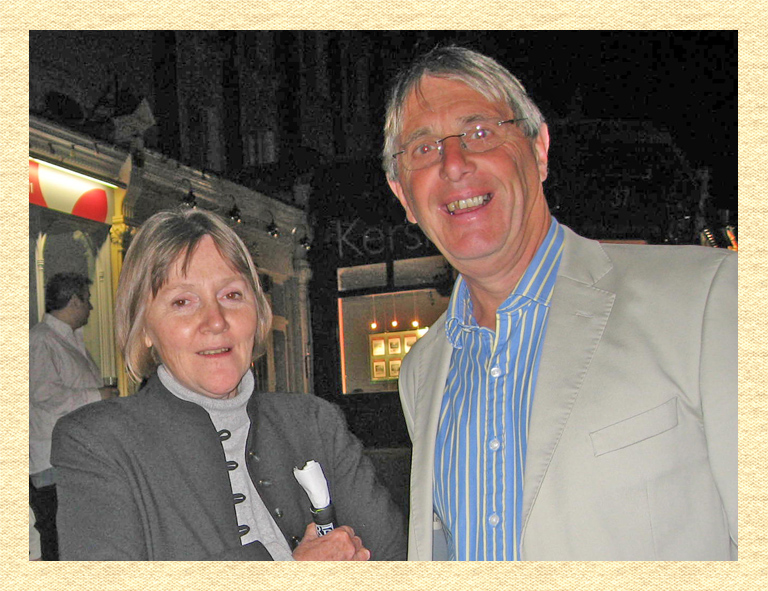Preparations and Thoughts
Jeff Lock and Gillian Smith
Planning and Route Finding

In 2008 I was a retired person but Gillian was still working and this continued to be the case until 2011. So we began doing the pilgrimage in sections, mostly in school half terms. The start of our first section in Spring 2008 was preceded by a winter of planning and research. We joined the Confaternity of St James, based at Blackfriars in London and attended a presentation on the practical issues of undertaking the camino. ( https://www.csj.org.uk/ )We made use of their shop and purchased a full guide to the Voie de Vezelay from Burgundy to the Pyrenees. Later we also obtained maps of the Spanish section Route finding in France was aided (nearly always) by the presence of Compostella signs at each junction or turning point. From Vezelay to the Pyrenees we were mostly walking alone and we had to watch our directions carefully but from St Jean Pied de Port onwards we were rarely out of sight of other pilgrims and route finding became fairly easy.
Pilgrim Passport
We also obtained our pilgrim credentials from the Confraternity of St James, which were stamped at each place we visited. When we set out, our expectation was that these would be churches or cathedrals but usually the stamps were applied by the hotels, refuges or B&Bs where we stayed.
Accommodation
We set out on the basis that "pilgrims do not book ahead" but this turned out to be the main day to day stress factor as we progressed. I'm not sure how we would have coped without mobile phones and Gillian's knowledge of the local language. Probably, In France, we would have always have found a bed but it might have been more rudimentary. In Spain accommodation was plentiful. Throughout the walk, Gillian was the one who undertook most of the research and planning.
Food
Hostels, and auberges usually provide an evening meal and there is also the option, in most places, of going to local bars, cafes or restaurants. it would also be very unusual to walk for a day without passing a bakers or supermarket where picnic food can be purchased.
Carrying Our Belongings
Throughout the pilgrimage we carried our own belongings in our own rucksacks. We were used to backpacking so this was no real hardship. As time went on, we learned to reduce everything to the bare minimum and our packs rarely weighed more than 7 or 8 kilos. However, there are companies that offer bag- carrying services on the popular sections of the camino..
Are We Religious ?
We both believe in God and go to church services at Easter and Christmas but the pilgrimage was really an adventurous project.
Long Distance Walking
Long routes such as pilgrimages are accomplished by dividing them into bite-sized chunks suited to the capacity of the walker. We rarely walked more than 20 miles in a day and often the distances were much shorter. I have been asked whether continuous walking like this is boring. My answer is definitely not. There is always something to see and bird-song to listen to. Of course, there are bad sections such as walking on endless roads in heavy rain but adversity has it own rewards. You feel a significant sense of accomplishment when your destination is reached. Seeing other countries in slow-time is a wonderful experience. Every village, every field, every waterway, every blade of grass is there for your inspection.
Weather
April brought us bad weather in France in 2008 and 2009 (lots of rain) and also in Spain for Gillian (wet, cold and miserable) when she walked from Pamplona to Leon. May gave us much more sunshine in France in 2010 and also during our final stretch to Compostella in 2012. The best weather of all was in Sept/Oct 2011 when i walked alone from Pamplona to Leon. Every day was sunny with hardly a cloud in the sky. This meant it was often far too hot but, in common with other pilgrims, I always started to walk at dawn and finished in the early afternoon.
Barking Dogs
In France, you will be barked at by many proprietorial dogs who regard the passing pilgrim as a threat to their homes and gardens. Ignore them. I once tried to counter them by installing a dog-scaring app on my phone but it proved totally ineffective.
Companionship
Having a companion to share experiences and consult about the problems of the trail is invaluable. But solo walking, especially in Spain also has its benefits. It promotes conversation with other pilgrims and can lead to lasting friendships.
Reflections
When we started on the Camino, I couldn't conceive why some people were doing it for a second or third time but since we have finished, it has left a void in my life both spiritual and as an absence of adventure. In 2018 we started out on another pilgrimage route, the Via Francigena from Canterbury to Rome, and as I write, in April 2020, 500 miles remain to be walked.
